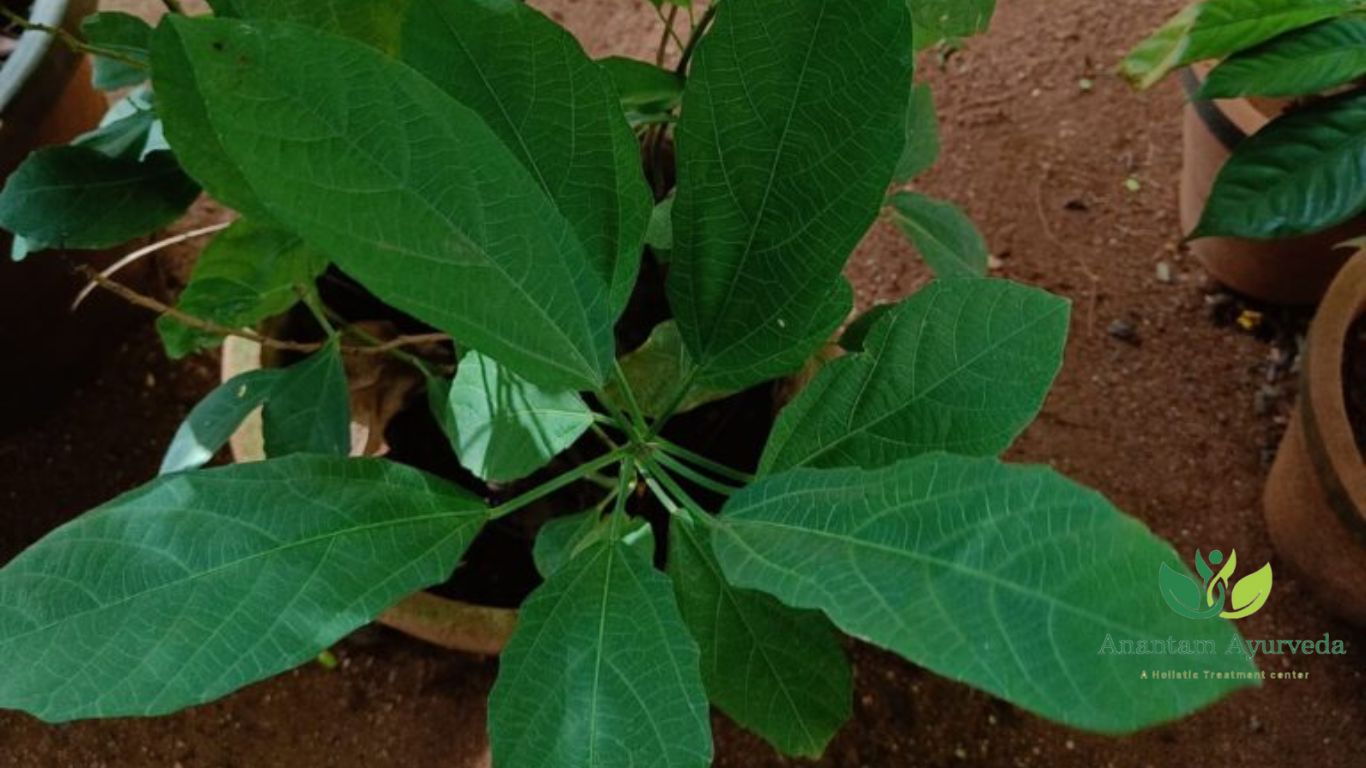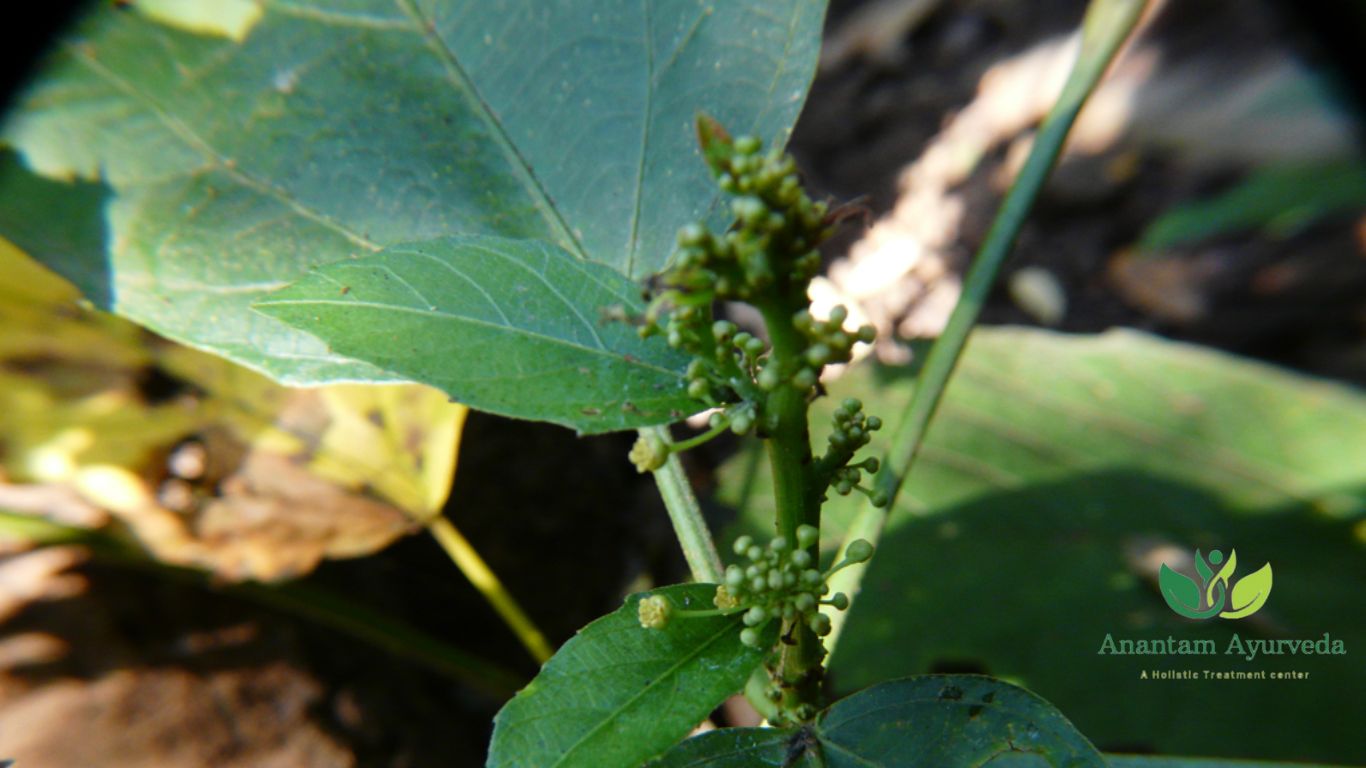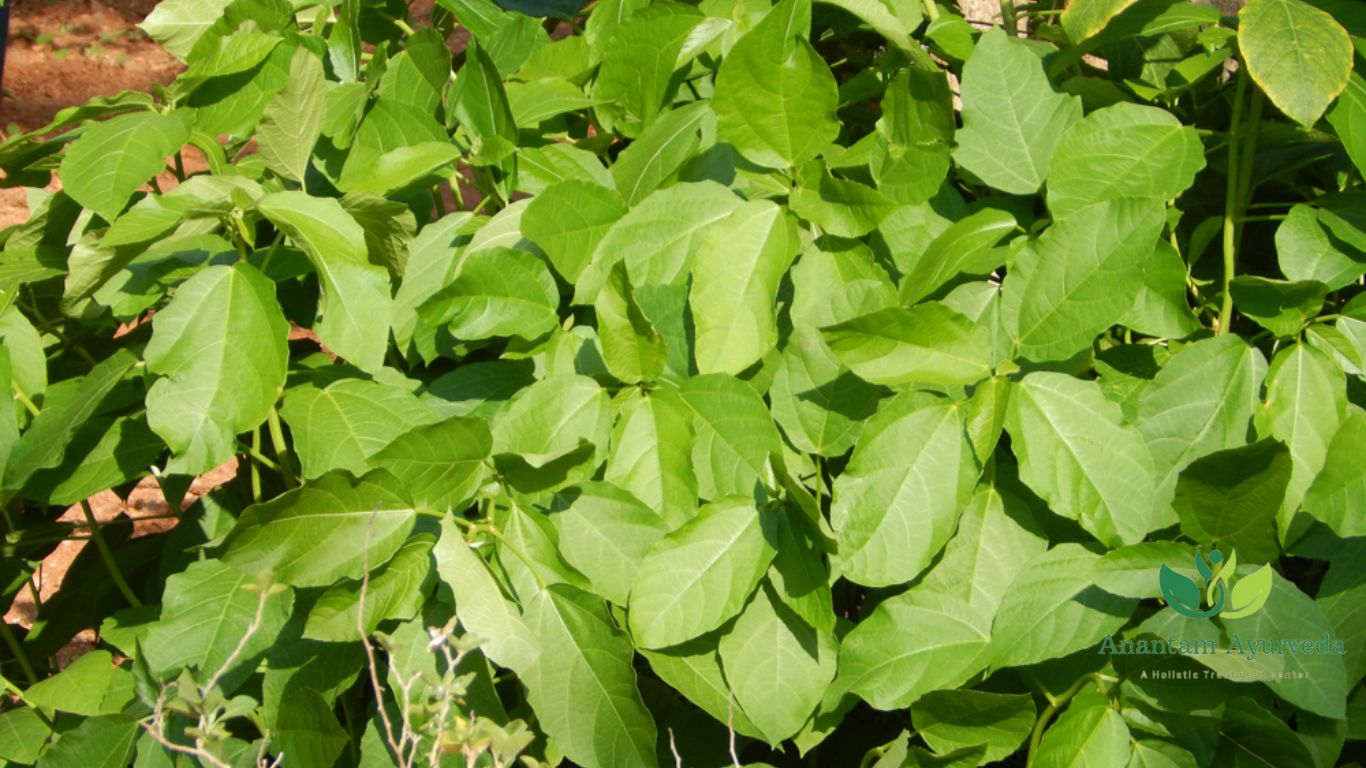Danti (Baliospermum montanum) : Benefits, Precaution & Dosage in Ayurveda
Introduction to Danti (Baliospermum montanum)
Ayurvedic practitioners revere Danti, scientifically known as Baliospermum montanum, for its potent purgative, anti-inflammatory, and detoxifying properties. This herb belongs to the Euphorbiaceae family and has been widely useful in traditional Ayurvedic treatments to manage various health conditions, particularly digestive disorders, skin diseases, and detoxification.
Danti holds a Sanskrit name, which signifies its ability to clear the bodily channels and act as an effective detoxifier. Its usage has been extensively documented in ancient Ayurvedic texts like Charaka Samhita, Sushruta Samhita, and Bhavaprakash Nighantu.

Vernacular Names of Danti
It is known by different names across various regions and languages:
-
English – Red physic nut, wild castor, wild croton, wild sultan seed
-
Hindi – Danti
-
Sanskrit – Danti, Hastidanti, Udumbaraparni, Erandaphala, Vishodhani
-
Tamil – Niradimuthi
-
Telugu – Cinna Nepalam
-
Bengali – Harun, Haphun
-
Marathi – Danti
Sanskrit Synonyms of Danti
It has multiple synonyms in Sanskrit, each describing a unique characteristic of the plant:
-
Hastidanti – The root resembles an elephant’s tusk
-
Udumbaraparni – The leaves resemble those of the Udumbara tree (Ficus racemosa)
-
Erandaphala – The fruits resemble castor fruits
-
Erandapatrika – The lower leaves resemble those of the castor plant (Ricinus communis)
-
Sheeghra – The herb spreads quickly in the body after consumption
-
Vishalya – It aids in removing deep-seated toxins
-
Vishodhani – It acts as a powerful cleanser and induces purgation
-
Madhupushpa – The flowers are rich in nectar
-
Nikumbha – Known for its purgative effect on the intestines
Botanical Classification, Description and Habitat of Danti
-
Botanical Name: Baliospermum montanum
-
Family: Euphorbiaceae
-
Plant Type: Small erect branching shrub
-
Habitat: Found in tropical and subtropical Himalayas, South India, and Sri Lanka
-
Leaves: Broad, ovate, resembling those of the castor plant
-
Flowers: Reddish in clusters
-
Fruits: Small, round, reddish-brown, resembling castor fruits
-
Seeds: Mottled and highly potent in medicinal use
- Roots: Thick, fibrous, and known for their strong medicinal properties
The root, seed, and leaves of Danti are primarily used in Ayurvedic medicine, with the root being the most potent part for medicinal applications.
It is a shrub that grows up to 1.5 meters in height, found predominantly in moist, tropical, and subtropical regions of India, Nepal, and Sri Lanka. It flourishes in forested areas, riverbanks, and foothills, making it a widely available medicinal plant.

Classical Ayurvedic Categorization of Danti
It has been classified under different Ayurvedic categories:
Charaka Samhita
-
Bhedaniya Gana – Group of herbs used for purgation (Virechana Karma)
-
Mulini Dravyas – Herbs where the root is the primary medicinal part
Sushruta Samhita
-
Shyamadi Gana – A group of medicinal herbs
-
Adhobhagahara Gana – Herbs beneficial for eliminating toxins through the rectum
Ashtanga Hridaya
-
Shyamadi Gana – Categorized among purgative herbs
Ayurvedic Properties of Danti
It possesses the following Ayurvedic properties:
- Rasa (Taste): Katu (Pungent)
- Guna (Qualities): Guru (Heavy), Teekshna (Sharp)
- Virya (Potency): Ushna (Hot)
- Vipaka (Post-Digestive Effect): Katu (Pungent)
- Dosha Effect: Balances Kapha and Vata doshas but can increase Pitta if used in excess.
- Prabhava (Special Effect): Purgative (Virechana) – Though it is similar to Chitraka (Plumbago zeylanica) in taste and properties, only Danti acts as a strong purgative.
These properties make it an effective herb for detoxification, digestion, and metabolic disorders.
Medicinal Properties and Benefits of Danti
It is valued for its diverse medicinal applications:
-
Virechana (Purgative Action) – Helps in detoxification and cleansing of the intestines
-
Shothahara (Anti-inflammatory) – Reduces swelling and joint pain
-
Krimighna (Anthelmintic) – Effective against intestinal worms
-
Raktashodhaka (Blood Purifier) – Useful in skin diseases and blood disorders
-
Yakrit Uttejaka (Liver Stimulant) – Enhances liver function and bile secretion
-
Udara Shamana (Anti-ascitic Action) – Reduces fluid accumulation in the abdomen

Therapeutic Uses and Benefits of Danti in Ayurveda
1. Powerful Laxative and Purgative
It is well-known for its strong purgative action (Virechana Karma). It is used in Ayurvedic Panchakarma therapies to remove excess toxins (Ama) from the body, especially in chronic constipation, indigestion, and intestinal blockages.
2. Effective in Skin Diseases
Due to its Tikta (bitter) and Ushna (hot) properties, Danti is beneficial in treating chronic skin disorders like eczema, psoriasis, and leucoderma. It helps in purifying the blood and reducing skin inflammation.
3. Beneficial for Liver and Spleen Disorders
Danti root is an excellent hepatoprotective herb used in treating jaundice, liver enlargement, and spleen disorders. It promotes bile secretion and enhances liver function.
4. Anti-Inflammatory and Pain-Relieving Effects
The root and seed extracts of Danti possess anti-inflammatory properties that help in relieving joint pain, arthritis, and muscle stiffness. It is used in the treatment of rheumatoid arthritis (Amavata) and gout (Vatarakta).
5. Anti-Parasitic and Anti-Microbial
It is highly effective in treating intestinal worms, bacterial infections, and microbial infestations. Its anthelmintic property makes it useful in treating helminthiasis and other gut infections.
6. Supports Respiratory Health
It is beneficial in respiratory conditions like asthma, bronchitis, and chronic cough. It helps clear excess mucus from the respiratory tract, making it a good remedy for Kapha-related disorders.
7. Useful in Ascites and Dropsy
It is a potent diuretic and helps in reducing fluid retention, swelling, and abdominal distension caused by conditions like ascites and dropsy.
8. Enhances Female Reproductive Health
In Ayurveda, it is used to promote menstrual health. It helps in treating dysmenorrhea (painful periods), irregular menstruation, and uterine disorders.
Varieties of Danti and Their Identification
Several ancient Ayurvedic scholars have classified Danti (Baliospermum montanum) into different varieties based on root color, potency, and therapeutic effects. The main classifications are:
-
Kaiyadeva Nighantu
-
Danti and Dravanti are considered two distinct varieties of Danti.
-
-
Chakrapani’s Commentary on Charaka Samhita
-
Danti: Has black-colored roots.
-
Dravanti: Has red-colored roots.
-
-
Bhavaprakasha Nighantu
-
Danti Dvaya (Two Types of Danti):
-
Laghu Danti (Smaller variety)
-
Brihat Danti (Dravanti) (Larger variety)
-
-
-
Raj Nighantu
-
Mentions two varieties:
-
Danti (Baliospermum montanum)
-
Bhadra Danti
-
-
Botanical Identification
-
Danti is identified as Baliospermum montanum.
-
Dravanti is identified as Croton tiglium or Jatropha curcas.
Geographical Distribution
Danti is widely distributed across India, particularly in:
-
Tropical and subtropical regions of the Himalayas
-
South India
-
Sri Lanka and Southeast Asia
This classification helps distinguish between different varieties and their specific therapeutic uses in Ayurveda.

Chemical Constituents of Danti
Baliospermum montanum contains several bioactive compounds that contribute to its medicinal properties. The major chemical constituents found in different parts of the plant are:
-
Root:
-
Baliospermin – Known for its purgative and detoxifying properties.
-
Montanin – Exhibits anti-inflammatory and antimicrobial effects.
-
-
Seeds:
-
Axillarenic Acid – Plays a role in anthelmintic (anti-parasitic) and laxative actions.
-
These compounds make it a powerful herb in Ayurveda, particularly for purgation therapy (Virechana), detoxification, and digestive disorders.
Part Used and Dosage
| Part Used | Dosage |
|---|---|
| Root Powder | 1–3 g |
| Seed Powder | 125–250 mg |
| Seed Oil | 2–5 drops |
Purification Method (Shodhana)
Since it is highly potent, it requires purification before use:
-
The root is coated with a paste made of:
-
Madhuka (Madhuca longifolia)
-
The coated root is wrapped in grass, tied, and covered with mud
-
It is then heated using fire and sunlight
-
This reduces toxicity and enhances medicinal properties
Danti in Ayurvedic Formulations
It is widely used in various Ayurvedic formulations and classical preparations:
- Dantyarishta – Used for liver disorders and digestive ailments.
- Churna – A powerful purgative powder for constipation.
- Ghrita – A medicated ghee preparation for skin diseases.
- Trivrit Lehyam – A formulation combining Danti with other herbs for detoxification.
- Taila – Medicinal oil for external application in arthritis and skin conditions.
Dosage and Usage of Danti
The dosage of Danti varies depending on the form of administration and individual health conditions.
- Powder (Churna): 250 mg – 1 gm (to be taken with honey or warm water)
- Arishta: 10–15 ml after meals
- Ghrita: 5–10 gm mixed with milk
Caution: It should be used only under the supervision of a qualified Ayurvedic doctor as its strong purgative action may cause abdominal cramps and dehydration if misused.
Precautions and Contraindications
While it is highly beneficial, it must be used with caution in certain individuals:
- Pregnant and lactating women should avoid it due to its strong uterine stimulant properties.
- People with weak digestion should take it in lower doses to prevent excessive purgation.
- Individuals with Pitta Prakriti should use Danti cautiously as it may increase heat in the body.
- Children and elderly should take it in minimal quantities due to its strong action.
Conclusion
Baliospermum montanum is a potent Ayurvedic herb with diverse medicinal properties. From digestive and liver health to skin and respiratory benefits, this herb plays a significant role in traditional Ayurveda. However, due to its strong purgative nature, it must be used judiciously and under proper medical guidance.
By incorporating Danti in the right way, we can harness its therapeutic potential for holistic well-being.

Frequently Asked Questions about Baliospermum montanum:
1. How to store it?
It should be stored in an airtight glass container and kept out of children’s reach. It should not be exposed to direct light and heat.
2. Which parts of Danti have medicinal importance?
The roots and seeds of Danti are considered medicinally important. The root should be cleaned, dried, and powdered before use.
3. Is it good for rheumatism?
It helps reduce symptoms of rheumatism such as joint pain and swelling. Rheumatism occurs due to weak digestive fire, leading to the accumulation of toxins (Ama) in the joints. It helps eliminate Ama due to its Deepan (appetizer) and Pachan (digestive) properties, providing relief.
4. What are the benefits of Danti for constipation?
It has strong laxative properties. It accelerates bowel movements and aids in easy stool excretion.
5. Is it effective for infections?
It has antimicrobial and antibacterial properties. It helps kill harmful microorganisms and prevents bacterial growth.
6. Can Danti help with skin allergies?
It helps manage skin allergies by inhibiting histamine release and reducing allergy-causing chemicals in the body. It also strengthens the immune system.
7. Does it boost immunity?
It has immunomodulatory properties that enhance the body’s defense mechanism by eliminating harmful foreign particles.
8. Does it has diuretic properties?
It increases urine production and reduces the risk of kidney stones.
9. Can Danti be beneficial for cancer?
It has been found to inhibit the growth of cancer cells and eventually destroy them.
10. Does it help in reducing inflammation?
It has anti-inflammatory properties that suppress the production of inflammatory chemicals like nitric oxide (NO) gas.
11. Can Danti help control parasitic worm infections?
Due to its anthelmintic properties, it suppresses parasite activity and aids in their removal from the body.
12. Can I take Danti root or seed powder without consulting a doctor?
You should take it only under medical supervision. It has strong laxative effects, especially the seeds, which may cause digestive issues.
13. Can Danti harm joints?
It has Vikashi Guna, meaning it can separate joints or tissues if consumed in excess.
14. Can Danti cause diarrhea?
Due to its strong laxative and hydragogue properties, high doses may lead to diarrhea or loose stools.
15. Is it toxic?
It is not inherently toxic, but it needs proper Shodhana (purification) before internal use.
16. Is it useful for dental problems?
There is insufficient scientific evidence for its use in dental issues. However, it can help manage gum inflammation and infections due to its Pitta-balancing and anti-inflammatory properties.
Tip: Chewing a few Danti leaves may help reduce bad breath.
17. Can Danti help with digestive problems?
It improves digestion and appetite due to its Pitta-balancing and Ushna (hot) properties.
18. Is it useful in managing jaundice?
It helps manage jaundice symptoms caused by Pitta imbalance by improving digestion and detoxifying the body.
19. Can Danti relieve joint pain?
Danti seed oil has anti-inflammatory and analgesic properties that reduce joint pain and swelling.
20. Is it effective for rheumatoid arthritis?
When applied externally, Danti seed oil reduces pain and swelling in rheumatoid arthritis.
21. Is it a hydragogue?
Danti seed oil is a powerful hydragogue, meaning it increases water elimination from the bowels.
22. Does it help in healing ruptured membranes?
Danti leaf paste aids in healing ruptured membranes due to its antioxidant and anti-inflammatory properties. It also prevents infections.
23. How does it help manage piles?
It reduces pain and inflammation in piles due to its anti-inflammatory properties.
24. Does it promote wound healing?
It helps heal wounds due to its antioxidant and antimicrobial properties. Applying Danti leaf juice prevents infection and pus formation.
25. Can Danti be used for fistula treatment?
It helps manage fistula by reducing pain and inflammation when applied externally. It is also useful for fistula treatment as it balances Pitta and reduces pus accumulation in the affected area.
26. How to Use it for External Application (Fistula, Wounds, Infections)?
-
Take Danti root as needed.
-
Grind it into a fine powder.
-
Take ¼–½ teaspoon of Danti root powder.
-
Mix with water or honey to make a paste.
-
Apply on the affected area 1–2 times daily.
-
This remedy helps reduce pus formation, pain, and swelling.
You can follow us on twitter, facebook, instagram & Google News
